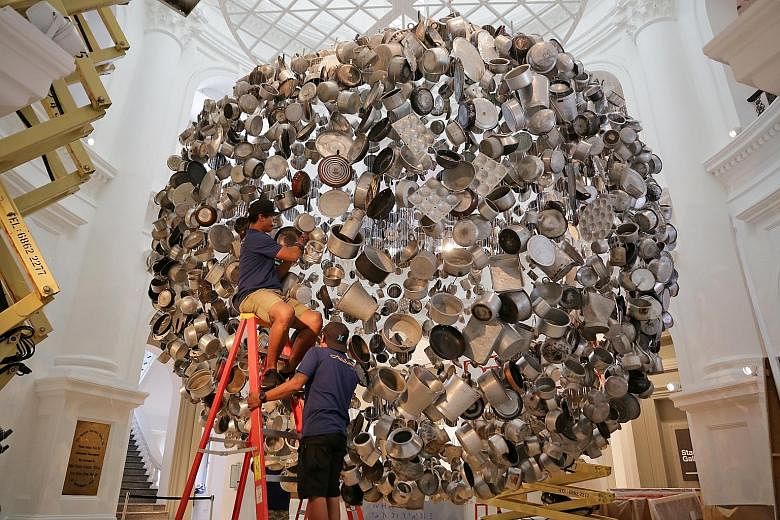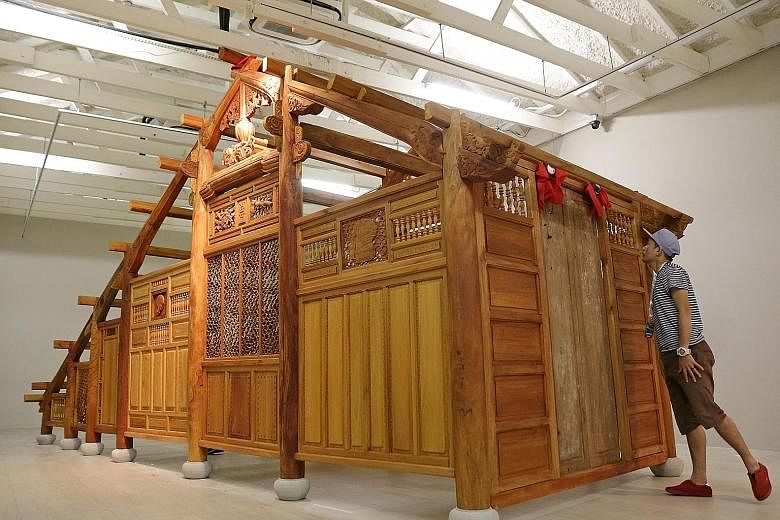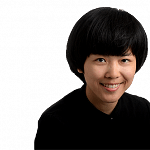Vietnamese artist Bui Cong Khanh's work almost did not make it to this year's Singapore Biennale, which is opening on Oct 27.
The large sculptural installation, made of wood and resembling a house, was stuck at sea for close to two weeks last month, after South Korean shipping company Hanjin, whose vessel was transporting the work from Vietnam, filed for receivership in August.
The shipper's woes left more than 100 cargo ships stranded at sea in various parts of the world. A number of vessels were turned away from some ports, while others refused to dock on fears of being seized by creditors.
In Singapore, port operator PSA Corp worked with Hanjin, shippers and consignees to release freight to customers.
Khanh's work, titled Dislocate, eventually arrived at the end of last month, in time for the biennale organised by the Singapore Art Museum.
The museum's curator, Ms Andrea Fam, tells The Straits Times that it is not common for delayed deliveries of artworks to be "shrouded in such uncertainty" and the museum had to draw up contingency plans should the work not arrive in time.
-
BOOK IT / AN ATLAS OF MIRRORS
WHERE: Various locations, but mainly Singapore Art Museum, 71 Bras Basah Road; and SAM at 8Q, 8 Queen Street
WHEN: Oct 27 to Feb 26, 10am to 7pm (Saturday to Thursday), 10am to 9pm (Friday)
ADMISSION: $15 (adults) and $7.50 (students and senior citizens) for Singapore citizens and permanent residents; otherwise, $20 (adults) and $10 (students and senior citizens)
"While we were working on backup plans, we got wind of good news that the work would arrive," she says. "And we were relieved to find, when we uncrated it, that it had not been affected by being out at sea longer than expected."
The sculpture, featuring delicate carpentry, was painstakingly carved over two years by artisans and the artist.
It is made of wood from the jackfruit tree and combines the wood- working artistry of Khanh's ancestral home in Fujian, China, with repurposed structures from a traditional wooden Vietnamese house. It includes motifs associated with Vietnamese and Chinese cultures and weaves together narratives on personal, social and national identities.
The work also embodies the theme of migration, which is among the nine sub-themes of the biennale, and its earlier predicament at sea, ironically, underscores the idea of displacement.
The biennale, titled An Atlas Of Mirrors, features 60 works of art by more than 50 artists, which trace and reflect the complex social, political, geographical and historical relationships shared by people and places in Asia.
The idea of real and imagined spaces, for example, is explored through the installation, Paracosmos, by Japanese artist Harumi Yukutake. The work, commissioned by the biennale, features more than 1,600 circular, hand-cut glass mirrors installed on the wall flanking the museum's main stairwell.
In the installation, Cooking The World, by Indian artist Subodh Gupta, kitchen utensils such as plates and pots are suspended to form a 6m-wide sphere to spotlight the untold stories and everyday experience of individuals.
The work is installed in the rotunda space of the National Museum of Singapore, which is one of seven venues for the biennale. The other venues include the Singapore Art Museum's annexe building in Queen Street and the Peranakan Museum in Armenian Street.
Artists whose works are exhibited at the biennale are eligible for the Benesse Prize, which comes with a cash reward of 3 million yen (S$40,000) and a commission to create a work to be exhibited at Benesse Art Site Naoshima, an art project on the small islands of Naoshima, Teshima and Inujima in Japan.
The prize is sponsored by Benesse Holdings, a Japanese company whose business interests include the fields of education, leadership training, lifestyle and nursing care.
The prize was launched in 1995 at the prestigious Venice Biennale and, until 2013, had been awarded in conjunction with the biennale in Italy. Its 11th edition, however, will be presented with the Singapore Biennale.
Benesse Art Site Naoshima's international artistic director Akiko Miki says it hopes that with the new collaboration, "we are able to deepen our involvement in the development of contemporary art in Asia, as well as enhance inter-regional exchanges and networks in the field".
Artists will be shortlisted by an international jury that includes the Singapore Biennale's creative director, Dr Susie Lingham, and Ms Miki. The shortlist will be announced at the opening of the biennale and the winner named in January.



